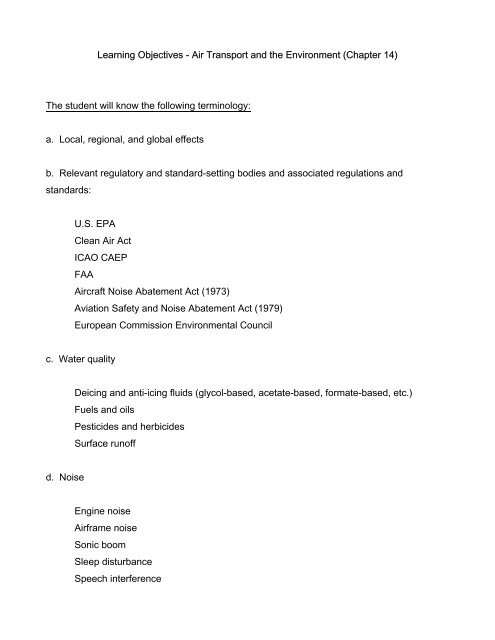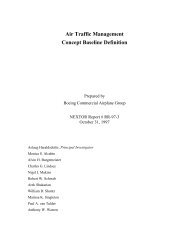Learning Objectives - Air Transport and the Environment (Chapter ...
Learning Objectives - Air Transport and the Environment (Chapter ...
Learning Objectives - Air Transport and the Environment (Chapter ...
Create successful ePaper yourself
Turn your PDF publications into a flip-book with our unique Google optimized e-Paper software.
<strong>Learning</strong> <strong>Objectives</strong> - <strong>Air</strong> <strong>Transport</strong> <strong>and</strong> <strong>the</strong> <strong>Environment</strong> (<strong>Chapter</strong> 14)<br />
The student will know <strong>the</strong> following terminology:<br />
a. Local, regional, <strong>and</strong> global effects<br />
b. Relevant regulatory <strong>and</strong> st<strong>and</strong>ard-setting bodies <strong>and</strong> associated regulations <strong>and</strong><br />
st<strong>and</strong>ards:<br />
U.S. EPA<br />
Clean <strong>Air</strong> Act<br />
ICAO CAEP<br />
FAA<br />
<strong>Air</strong>craft Noise Abatement Act (1973)<br />
Aviation Safety <strong>and</strong> Noise Abatement Act (1979)<br />
European Commission <strong>Environment</strong>al Council<br />
c. Water quality<br />
Deicing <strong>and</strong> anti-icing fluids (glycol-based, acetate-based, formate-based, etc.)<br />
Fuels <strong>and</strong> oils<br />
Pesticides <strong>and</strong> herbicides<br />
Surface runoff<br />
d. Noise<br />
Engine noise<br />
<strong>Air</strong>frame noise<br />
Sonic boom<br />
Sleep disturbance<br />
Speech interference
Hypertension<br />
Effective perceived noise level (EPNL)<br />
Day-night noise level (DNL)<br />
A-weighted sound energy<br />
Noise contour<br />
Noise performance “stages”<br />
e. Surface air quality<br />
carbon dioxide<br />
water vapor<br />
nitrogen oxides<br />
unburned hydrocarbons<br />
carbon monoxide<br />
sulfur oxides<br />
hazardous air pollutants<br />
particulate matter<br />
ozone<br />
energy intensity<br />
stage length<br />
l<strong>and</strong>ing-takeoff cycle<br />
National Ambient <strong>Air</strong> Quality St<strong>and</strong>ards<br />
criteria pollutants<br />
non-attainment area<br />
state implementation plan<br />
f. Climate<br />
troposphere<br />
stratosphere<br />
carbon dioxide<br />
water vapor
nitrogen oxides<br />
methane<br />
condensation trails<br />
radiative forcing<br />
emissions trading<br />
alternative fuels<br />
The student will be able to perform <strong>the</strong> following:<br />
a. Estimate noise impacts for different aircraft types <strong>and</strong> different numbers of operations.<br />
b. Estimate air-quality impacts for different aircraft types <strong>and</strong> different numbers of operations.<br />
c. Estimate fuel consumption <strong>and</strong> CO 2 production for different aircraft types <strong>and</strong> different<br />
numbers of operations.
















